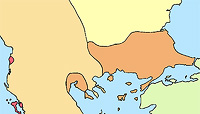 |
|
 |
Expansion of the Serbs
 hen
John VI
came to power, the Empire was so weakened by the internal conflicts that it was in no
hen
John VI
came to power, the Empire was so weakened by the internal conflicts that it was in no
 position to undertake any military operations. The new emperor, therefore, initiated a policy of intense diplomatic action. He endeavoured to strengthen Byzantine influence in Russia and the Empire of Trebizond, while he also continued to maintain friendly relations with the
Mamluks
of Egypt. position to undertake any military operations. The new emperor, therefore, initiated a policy of intense diplomatic action. He endeavoured to strengthen Byzantine influence in Russia and the Empire of Trebizond, while he also continued to maintain friendly relations with the
Mamluks
of Egypt.
Kantakouzenos' main concern was the Serbian expansion in Macedonia.
Stefan Dusan,
who had been crowned emperor in April 1346, completed his conquest of Epiros in 1348 and subdued Thessaly at the same time. He thus established a state which extended, roughly, from the Danube to the Gulf of Corinth and from the Adriatic to the river Nestos in eastern Macedonia. In essence, only Thessalonike and Constantinople remained to be conquered. The former was still in the hands of the Zealots and here the Byzantines finally prevailed. At the end of 1349 the Zealot regime collapsed, and their leader, Andrew Palaiologos, sought refuge with the
Serbs,
to whom, besides, he wished to surrender the city. The imperial governor, Alexios Metochites, called for Kantakouzenos to intervene. The latter, together with John V, recovered the city at the end of 1350. As for Constantinople, Dusan needed a fleet to take the city. Venice, which Dusan approached for assistance, was in no way disposed to replace the Byzantine Empire with a powerful Serbian one. Dusan's efforts therefore remained fruitless. John VI undertook two military operations against the Serbs, in 1348 and in 1350, which, however, scored only a few minor successes.
|